Related Research Articles

Long Beach is a coastal city in southeastern Los Angeles County, California, United States. It is the 44th-most populous city in the United States, with a population of 451,307 as of 2022. A charter city, Long Beach is the seventh-most populous city in California, the second most populous city in Los Angeles County, and the largest city in California that is not a county seat.
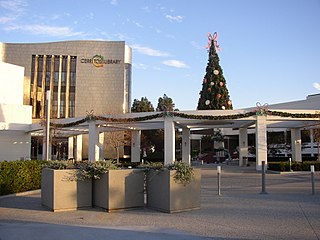
Cerritos is a city in Los Angeles County, California, United States, and is one of several cities that constitute the Gateway Cities of southeast Los Angeles County. It was incorporated on April 24, 1956. As of 2019, the population was 49,859. It is part of the Los Angeles–Long Beach–Anaheim, California Metropolitan Statistical Area designated by the Office of Management and Budget.
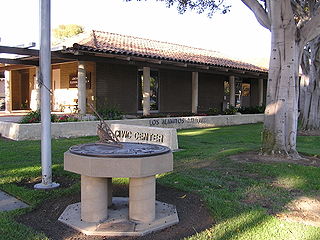
Los Alamitos is a city in Orange County, California. The city was incorporated in March 1960. The population was 11,780 at the 2020 census, up from 11,449 at the 2010 census. The adjacent unincorporated community of Rossmoor uses the same 90720 ZIP code in its mailing address, but is not part of the city. The Los Alamitos Race Course is named for the city, but lies in the neighboring city of Cypress.
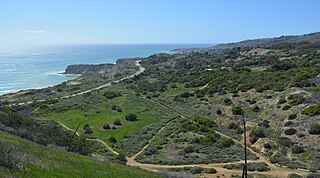
The Portuguese Bend region is the largest area of natural vegetation remaining on the Palos Verdes Peninsula, in Los Angeles County, California. Though once slated for development including the projected route of Crenshaw Boulevard, the area is geologically unstable and is unsuitable for building.
Bixby Knolls is a neighborhood in Long Beach, California, named after the Bixby family.

Wardlow station is an at-grade light rail station on the A Line of the Los Angeles Metro Rail system. The station is located on the A Line's exclusive right-of-way that parallels Pacific Place, at its intersection with Wardlow Street, after which the station is named, in the Wrigley neighborhood of Long Beach, California.

Rancho de los Palos Verdes was a 31,629-acre (128.00 km2) Mexican land grant in present-day Los Angeles County, California given in 1846 by Governor Pío Pico to José Loreto and Juan Capistrano Sepulveda. The name means "ranch of the green trees". The grant encompassed the present-day cities of the Palos Verdes Peninsula, as well as portions of San Pedro and Torrance.
California Heights is a historic neighborhood of Long Beach, California.

The Long Beach Police Department provides law enforcement for the city of Long Beach, California.
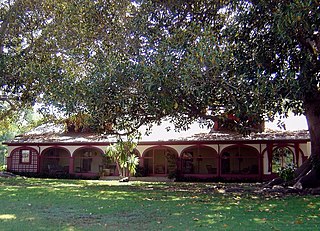
Rancho Los Alamitos takes its name from an 1834 Mexican partition of the 1784 Rancho Los Nietos, a Spanish concession, covering an area in present-day California's southwestern Los Angeles County and northwestern Orange County. Los Alamitos means the Little Cottonwoods or Poplars in Spanish, after the native Fremont Cottonwood trees there.

Los Cerritos Ranch House, also known as Rancho Los Cerritos or Casa de los Cerritos, in Long Beach, California, was "the largest and most impressive adobe residence erected in southern California during the Mexican period". Los Cerritos means "the little hills" in English. It was declared a National Historic Landmark in 1970. It is currently a museum.
Los Cerritos is a neighborhood with approximately 700 homes and 2,000 residents located within the Bixby Knolls neighborhood of Long Beach, California. Established in 1906, the Los Cerritos neighborhood has been used by the film industry of Hollywood with its historic, estate-sized homes. It was one of three finalists in the 2007 Neighborhood of the Year national competition.
Rancho Los Cerritos was a 27,054-acre (109.48 km2) 1834 land grant in present-day southern Los Angeles County and Orange County, California The grant was the result of a partition of the Rancho Los Nietos grant. "Cerritos" means "little hills" in Spanish. The rancho lands include the present-day cities of Cerritos, Paramount, Bellflower and Long Beach.

The Bixby family is an American family that was heavily involved in the development of California ranches and real estate in the 19th and 20th centuries. Through various companies, they controlled at one time or another large swathes of California real estate, much of it derived from Mexican land grants. Over several generations, their holdings included Rancho Los Cerritos and Rancho Los Alamitos, and parts of Rancho San Justo and Rancho Palos Verdes, totaling well over 100,000 acres. Parts of the towns of Long Beach, Bellflower, Paramount, Signal Hill, Lakewood, and Los Alamitos emerged from former Bixby-held lands. Within Long Beach, the neighborhoods Bixby Hill, Bixby Knolls, and Bixby Village are named after the family, as well as Bixby Park in the Alamitos Beach neighborhood.
Sarah Bixby Smith (1871–1935) was a California writer and an advocate of women's education. Adobe Days, her memoir of growing up in southern California, is considered a classic of the genre.
Sophie Jewett, also known under the pseudonym Ellen Burroughs, was an American lyric poet, translator, and professor at Wellesley College. Much of her poetry contains lesbian themes.
The Bixby land companies were a group of California-based land companies founded by various members of the Bixby and Flint families from Maine. In the late 19th and early 20th centuries, the firms of Flint, Bixby & Company, J. Bixby & Company, J. W. Bixby & Company, the Alamitos Land Company, and the Bixby Land Company controlled large swathes of California real estate, much of it derived from Mexican land grants. At various times their holdings included Rancho Los Cerritos, Rancho Los Alamitos, half of Rancho San Justo, and part of Rancho Palos Verdes together with other property in San Benito, Santa Barbara, and Los Angeles counties. Parts of the towns of Long Beach, Bellflower, Paramount, Signal Hill, Lakewood, and Los Alamitos emerged from former Bixby-held lands.
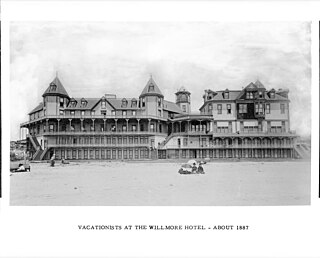
William Erwin Willmore was an English-born American headmaster and the founder of a small colony named after him, Willmore City in 1876. This piece of land, roughly 4000 acres, partitioned from the former Los Cerritos ranchero, was bought by Jotham Bixby, who helped found what would initially become the city of Long Beach, California. Willmore City was initially incorporated as a neighbourhood of the city of Long Beach in 1886.
Willmore is a neighborhood in Long Beach, California. It is adjacent to Downtown Long Beach.

Bixby Slough was an ancient wetland in Los Angeles County, California. Also known as Machado Lake, the slough was a "large freshwater wetland in the Carson-Harbor City-Wilmington area" that flowed into San Pedro Bay about three or four miles west of Dominguez Slough. Originally a "network of sloughs, nondescript streams and bogs in the harbor district," over time the Port of Los Angeles was carved “out of the mud flats and shallow waters that edged the ranchos of San Pedro and Palos Verdes.” About 90 percent of wetland ecosystems in Los Angeles County have been destroyed, with the losses in the highly urbanized South Bay "especially acute" and one biologist calling the draining of Bixby Slough and other harbor-area wetlands a “"wipeout".
References
- ↑ Her first name was regularly misspelled 'Fannie' in press reports.
- 1 2 3 4 5 6 7 8 9 10 11 12 Harris, Marcia Lee. Fanny Bixby Spencer: Long Beach's Inspirational Firebrand.
- 1 2 3 4 5 6 7 8 9 10 11 Scott, Marjorie. "Out of the Past: The Eccentric Millionaire". Orange Coast Magazine, August 1989, pp. 39-40.
- 1 2 3 4 5 6 7 Rasmussen, Cecilia. "From Roots of a Socialite, a Social Activist Grew". Los Angeles Times, January 19, 2003.
- ↑ Zint, Bradley (February 12, 2013). "Historical society hosts city 'founder'". Los Angeles Times. Retrieved 22 July 2020.
- 1 2 3 4 Surf City Writer. "Fanny Bixby Spencer: Living Outside of the Lines". September 14, 2012. Historic Wintersburg.
- ↑ Brown, Kathleen A. " 'Dissenters from the Religion of Patriotism': Women's Poetic Responses to World War I in the Oakland (CA) World." Peace & Change, January 20, 2015.